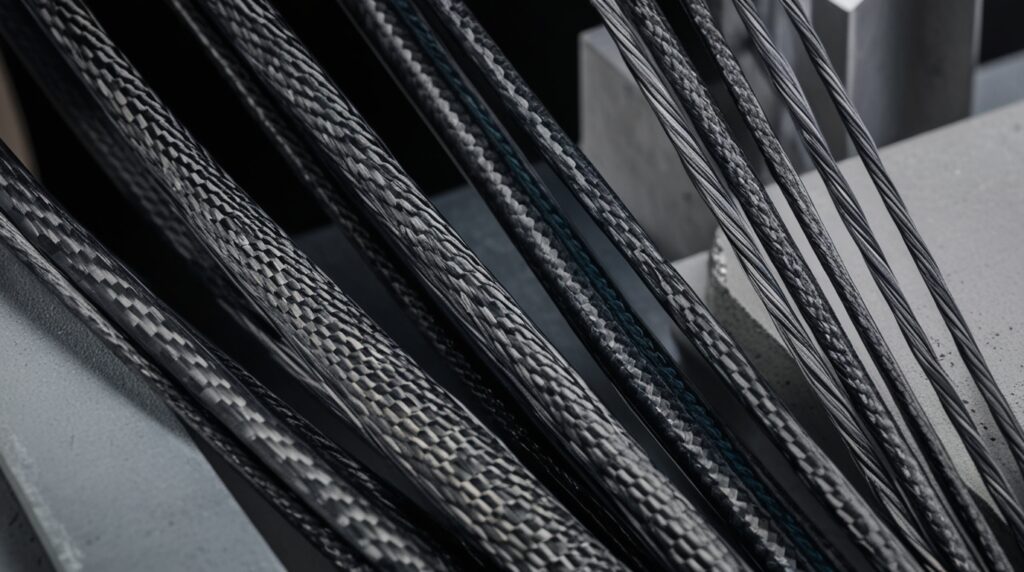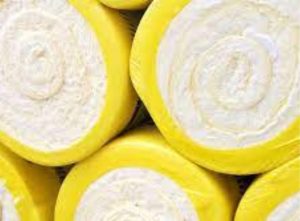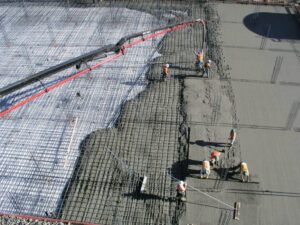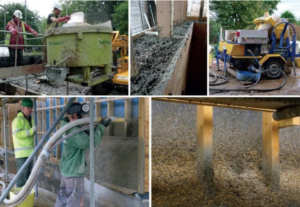The construction industry is always looking for better materials that are strong, light, and sustainable. As construction projects become more ambitious, they require materials that can meet these new demands. One material gaining attention is carbon fiber, known for its high strength and light weight. While carbon fiber has been widely used in aerospace and automotive industries, its potential in construction is just beginning to be explored. This article explores the future of carbon fiber in construction, looking at its properties, current uses, benefits, and the challenges that need to be addressed to fully utilize its potential.
What is Carbon Fiber?
Carbon fiber is a material composed of thin, strong crystalline filaments of carbon that are woven together to form a fabric, which can then be combined with resin to create a composite material. The key to carbon fiber’s strength lies in its structure—each carbon atom is bonded to several other carbon atoms, forming a pattern that gives the material its incredible tensile strength.

There are two primary types of carbon fiber: PAN-based (polyacrylonitrile) and pitch-based. PAN-based carbon fiber is the most common, known for its balance of strength, stiffness, and cost-effectiveness. Pitch-based carbon fiber, on the other hand, offers higher stiffness and is used in applications requiring superior performance, such as aerospace components.
Key Properties of Carbon Fiber
Carbon fiber boasts several properties that make it attractive for construction:
High Strength-to-Weight Ratio
Carbon fiber is five times stronger than steel but much lighter, making it ideal for structures where weight is a critical factor.
Corrosion Resistance
Unlike steel, carbon fiber does not corrode, which significantly increases the lifespan of structures exposed to harsh environments.
Thermal Stability
Carbon fiber holds up well in both hot and cold climates, maintaining its strength and shape.
Fatigue Resistance
It can handle repeated stress without weakening, which is important for structures like bridges and tall buildings.
Comparison with Traditional Materials
When compared to materials like steel, aluminum, and concrete, carbon fiber stands out:
Carbon Fiber VS Steel
Steel is strong but heavy and can rust. Carbon fiber offers similar or better strength without the weight and corrosion issues.
Carbon Fiber VS Aluminum
Aluminum is light but not as strong as carbon fiber. Carbon fiber also handles repeated stress better, making it more durable.
Carbon Fiber VS Concrete
Concrete is strong in compression but weak in tension, requiring steel reinforcement. Carbon fiber can replace or support steel in concrete, offering better strength without adding much weight.
Read Also : The different concrete types in construction
Current Applications of Carbon Fiber in Construction
Structural Components
Carbon fiber is being used more in construction as a reinforcing material for concrete, known as carbon fiber-reinforced polymer (CFRP). CFRP is used to strengthen existing structures and build new ones that need high strength but low weight. For example, CFRP is used in bridges to reinforce concrete beams, allowing for longer spans without extra supports.
Infrastructure Projects
Carbon fiber is also being used in major infrastructure projects. It is used in pipelines and tunnels to increase durability and reduce maintenance costs. In earthquake-prone areas, carbon fiber is used in retrofitting buildings to help them withstand earthquakes without adding much weight.
Architectural Design
Carbon fiber’s flexibility allows for creative architectural designs. Architects are using it to build complex, lightweight structures that are hard to achieve with traditional materials. Examples include futuristic canopies, facades, and even entire building frameworks.
Advantages of Carbon Fiber in Construction
Strength and Durability
Carbon fiber’s biggest advantage is its strength compared to its weight. This allows for the construction of buildings and structures that are stronger and lighter than those made with traditional materials. This is especially useful in bridge construction, where reducing the weight of materials can lower costs and improve design.
Lightweight Nature
Carbon fiber’s light weight helps in many ways. It reduces the load on foundations, potentially saving on materials and labor. Transporting and handling carbon fiber components is also easier and cheaper than with heavier materials like steel and concrete, which can speed up construction and lower costs.
Corrosion Resistance
Carbon fiber does not rust or corrode, even in harsh environments like saltwater or extreme temperatures. This makes it a great choice for structures in coastal areas, bridges, and other infrastructure that face tough conditions. The result is a longer lifespan and lower maintenance costs.
Design Flexibility
Carbon fiber’s flexibility allows for new design possibilities. Its strength lets architects create complex shapes and structures that would be hard to build with traditional materials. Carbon fiber can also be combined with other materials to create hybrid structures, taking advantage of the best qualities of each material.
Sustainability
As the construction industry focuses more on sustainability, carbon fiber offers several benefits. Its durability means that structures need less maintenance and have longer lifespans, reducing the need for repairs and replacements. Because carbon fiber is so strong, less material is needed, which can lower the environmental impact of construction projects.
Challenges and Limitations
Cost Factors
The biggest barrier to the widespread use of carbon fiber in construction is its high cost. The production process is energy-intensive and expensive, making carbon fiber more costly than traditional materials like steel or concrete. This makes it less feasible for large projects, especially in cost-sensitive areas like residential construction.
Production and Supply Chain
The supply chain for carbon fiber is not as developed as that for traditional materials. Challenges include the availability of raw materials, the complexity of manufacturing, and the need for specialized equipment. Scaling up production to meet the needs of the construction industry is also a significant challenge.
Technical Challenges
Carbon fiber’s unique properties also pose some technical challenges. For example, bonding carbon fiber with other materials can be tricky and requires special adhesives and techniques. Its rigidity can make it hard to work with in some cases, especially when creating complex shapes or curves. Skilled labor and specialized equipment are needed to properly install carbon fiber, adding to costs.
Recycling and Disposal
While carbon fiber is durable, disposing of it at the end of a structure’s life cycle poses environmental challenges. Recycling carbon fiber is currently difficult and not widely practiced, raising concerns about its long-term sustainability. Developing effective recycling methods is an ongoing research area, but until these methods are more accessible and cost-effective, the environmental impact of carbon fiber remains an issue.
Innovations and Future Developments
Advances in Manufacturing Techniques
There are exciting developments in manufacturing that could lower costs and increase production efficiency for carbon fiber. New methods like automated production processes and 3D printing with carbon fiber could make the material more affordable for more construction projects.
Hybrid Materials
Researchers are also developing hybrid materials that combine carbon fiber with other composites to improve performance while reducing costs. For example, combining carbon fiber with glass fiber or other materials can create tailored composites suited for specific applications.
Smart Carbon Fiber
Integrating smart technology into carbon fiber composites is another promising area. Embedding sensors within carbon fiber materials could allow for real-time monitoring of a structure’s health, providing data on stress, temperature, and other factors. This could lead to safer, more efficient buildings and lower maintenance costs.
Potential for Widespread Adoption
As production techniques improve and costs come down, carbon fiber could see more widespread use in construction. Its unique properties make it ideal for many applications, from high-rise buildings to infrastructure projects. The ongoing focus on sustainability and the need for durable materials will likely drive more interest in carbon fiber.
Research and Development
Ongoing research and development are key to fully unlocking carbon fiber’s potential in construction. Universities, research institutions, and private companies are all working on innovations that could make carbon fiber more affordable, easier to work with, and more sustainable. These efforts will play a critical role in shaping the future of carbon fiber in the construction industry.
The Future Outlook of Carbon Fiber in Construction
Market Trends
The market for carbon fiber in construction is expected to grow rapidly. As more projects showcase its benefits and costs decrease, carbon fiber is likely to be used more widely. This growth is driven by the need for stronger, more durable materials that can meet modern construction demands.
Potential for Mass Adoption
Mass adoption of carbon fiber in construction will depend on several factors, including advancements in manufacturing that reduce costs. As more successful projects demonstrate its benefits, adoption is likely to increase, especially in infrastructure and high-rise construction.
Role in Sustainable Construction
As the industry continues to focus on sustainability, carbon fiber could play a key role. Its durability, low maintenance needs, and potential for reducing material usage make it appealing as a sustainable option.
Technological Advancements
Advances in technology will likely continue to drive the use of carbon fiber in construction. New manufacturing techniques, smart materials, and hybrid composites could make carbon fiber more accessible and versatile. These advancements could open up new applications and drive innovation in the construction industry.
Conclusion
The future of carbon fiber in construction is promising. Its unique properties make it an attractive choice for a range of applications, from infrastructure to high-rise buildings. As the industry continues to evolve, carbon fiber could play a key role in shaping the future of construction, offering a strong, lightweight, and sustainable alternative to traditional materials.





